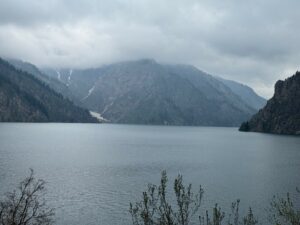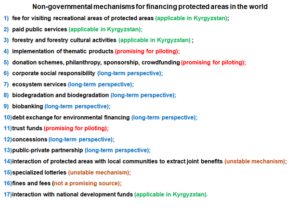The Sary-Chelek Nature Reserve, established in Kyrgyzstan in 1959, hosted a seminar to review existing and potential mechanisms for financing specially protected natural areas (SPNA).
“Today the state funding of protected areas includes three areas: salaries for employees, taxes and social contributions. Financial support is also needed for the development of scientific activities in the protected areas, monitoring the state of flora and fauna, and purchasing the necessary equipment and machinery. Therefore, we help SPNA to find new financing mechanisms or improve existing mechanisms for obtaining extra-budgetary revenues,” says Kuban Matraimov, the Director of the Regional Environmental Centre for Central Asia (CAREC) in the Kyrgyz Republic.
The seminar gathered representatives of the Department of Biodiversity Conservation and Pas of the Kyrgyz Republic, local tourism organizations, non-governmental organizations, local authorities and specialists from Sary-Chelek Nature Reserve.


For information: Sary-Chelek State Reserve is located in the western part of Kyrgyzstan, in the Aksy district of the Jalal- Abas region. Founded in 1959, its current area is 23,868 hectares. In 1978, the reserve was declared a world biosphere reserve by UNESCO . The reserve is located at altitudes from 1200 to 4247 meters above sea level. The name Sary-Chelek is translated from Kyrgyz as “Yellow Bowl”. The reserve has a system of 7 lakes, and the largest of them in area is Lake Sary-Chelek, which is the third largest in Kyrgyzstan. The territory of the reserve is a unique geographical place where coniferous forests come into contact with walnut forests of Kyrgyzstan. The visitor witnesses the growth of unique species of shrubs, junipers, wild apple trees, pear trees, hawthorn and natural species of peony and tulips. The wildlife of the reserve is rich: bear, red deer, fallow deer, porcupine, marten, argali, wild boar, ibex, and 157 different species of birds live here.

As at the previous seminar in the Issyk-Kul region, participants learnt about the global experience in financing specially protected natural areas.
Today, Kyrgyzstan uses only 4 out of 17 different mechanisms for financing the conservation of biodiversity and protected areas. An important step for the successful implementation of new and improvement of existing financing mechanisms is piloting with obtaining certain positive results, which will be the basis for their subsequent application in all protected areas.

This seminar was held as part of the project “Feasibility study of an effective system of financial self-sufficiency of protected areas (PAs)” implemented by the CAREC Branch in Kyrgyzstan with the support of UNDP-BIOFIN.
Contact person – Kuban Matraimov, Director of the CAREC Branch in Kyrgyzstan, kmatraimov@carececo.org
